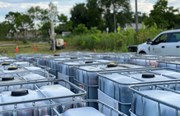Considerations for Meeting Site Goals on In Situ Thermal Remediation Projects
By: CascadeConsultants and site owners working on thermal remediation projects can avoid costly mistakes such as inadequate shallow treatment, shallow contaminant condensation, loss of pneumatic control, fugitive emissions, water infiltration into the wellfield and more, through the appropriate installation of the right vapor cover.
Thermal conduction heating (TCH), steam-enhanced extraction (SEE), and electrical resistance heating (ERH) are thermal technologies widely used to effectively clean up a variety of chemicals from different geological settings, ranging from tight clays to lose permeable sands. The depth to the top of the contaminated area, contaminant type, vadose zone, geology, vapor extraction strategy, and location of the water table are all factors influencing whether or not the surface of a thermal site will need a vapor cover during a thermal remedy.

On Wednesday, October 17th, Steffen Griepke, Cascade Thermal’s Technical Director of TCH and SEE, presented the webinar, “Thermal Remediation Vapor Covers: Why & How”. In his presentation, Steffen explained why a vapor cover is often needed on thermal remediation sites, along with the potential risks a client may take if a vapor cover is not installed during the thermal remedy at their site.

TerraTherm is optimizing the vapor cover configuration for each of our thermal sites. We are utilizing several different vapor cap configurations, ranging from thin HDPE liners over concrete slabs with limited to no insulation value and to insulating air-entrained concrete covers. For some sites, more sophisticated layered sandwich caps are utilized to increase the performance of the thermal system.
If you missed Steffen’s webinar, you can still watch the recording.
WATCH RECORDING
TerraTherm is also participated in a comprehensive sustainability study, to look for ways of improving the environmental footprint of thermal remedies. The study was published in the peer-reviewed journal, Groundwater Monitoring & Remediation and titled, “Optimizing the Environmental Performance of In Situ Thermal Remediation Technologies Using Life Cycle Assessment”. Steffen was a co-author of this paper and relevant findings, along with a number of more recent case study examples demonstrating the importance of a properly installed vapor cap, are discussed in his educational webinar.
Cascade’s 2018 webinar series is winding down but will pick up again in 2019. Recordings for all webinars presented are available on our webinar page.

